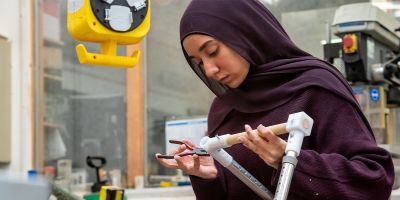Groundbreaking vine robots with magnetic skin could transform cancer treatment

A new class of robot with magnetic skin and movement that mimics creeping vine plants, could transform cancer diagnosis and treatment, according to a new University of Leeds study.
The soft, slender, “magnetic vine robots” developed by Leeds researchers not only “grow” as they move, they can also squeeze through gaps almost 40 per cent thinner than their resting diameter. This enables them to navigate narrow, complex pathways deep inside the human body, such as the bronchial tree.
By magnetising their ‘skin’ and controlling them using external magnets, academics say the little plastic robots are so manoeuvrable they can even navigate an ‘S’ bend, meaning they could potentially be used to treat tumours in the deepest, most difficult-to-reach parts of the lungs.
Engineers, scientists and clinicians based at the University’s STORM Lab, Future Manufacturing Processes Research Group and the Morimoto Lab at the University of California San Diego (UCSD), have collaborated on developing this technology. They hope it will pave the way for a revolution in the field, leading to advanced less invasive surgical tools that can be precisely steered through intricate and sensitive areas of the human body.
These new robots represent a significant advancement in surgical navigation technology that could benefit millions of people.
Professor Pietro Valdastri, Director of the STORM Lab and research supervisor said: “There are a number of current procedures that could greatly benefit from this technology in the future. For example, current technologies to look inside a patient’s lungs or take samples – a bronchoscopy – cannot easily reach most of the airways because it is so difficult to navigate the instrument by pushing it into the patient’s body.
“The difficulty of the procedure limits capacity in the healthcare system, resulting in long waiting lists and likely progression of the disease.”
Significant advancement
Vine robots use pneumatic pressure on the inside to grow, and magnetics to steer. While many organisations are looking at using vine robots for clinical applications, the Leeds and UCSD team believe they are the first to combine them with magnetics.
Professor Valdastri said: “Our findings highlight the success of our proposed magnetic steering methodology. These new robots represent a significant advancement in surgical navigation technology that could benefit millions of people.
“They have the potential to improve the safety and efficacy of medical procedures – from diagnoses to biopsies and treatment - reducing recovery times and minimizing surgical risks.”
The results of their investigations, which were funded by the European Research Council, are published in IEEE Robotics and Automation Letters.
Because of the way these robots move by growing, there is no friction, meaning they can move through difficult pathways easily and they’re less likely to damage surrounding tissue.
Inspired by plants
Vine robots are inspired by the plant kingdom: they grow and move around obstacles like a vine that grows around trees and rocks.
They use pneumatic pressure, meaning when the air inside is compressed, the volume decreases while its pressure increases. Their inverted internal structure can be compared to a sock that has been partially turned inside out. By pulling a tether attached to the tip of the inside-out section, the robot becomes smaller.
When the tether is released and pressure is applied on the inside, it becomes longer by folding outwards.
This growing capability means it can gently make its way through collapsed tubes without resistance, opening up pathways for cameras or other tools – something other devices are unable to do.
The report’s lead author Josh Davy carried out the research while conducting his PHD in Leeds’ School of Electronic and Electrical Engineering. He said: “A surgeon pushing a catheter through the body creates friction and discomfort but because of the way these robots move by growing, there is no friction, meaning they can move through difficult pathways easily and they’re less likely to damage surrounding tissue.
“Also, many cavities in the body are collapsed – such as in the brain or in the gastrointestinal tract - and we need a way to expand them, to enable navigation.
“These robots can open up a collapsed tube - which others can’t do. And once they've grown, you've got a channel that you can then put tools or a camera down, so they have much greater potential.”
Mr Davy said he was excited by the potential for improved outcomes, particularly for lung cancer patients, adding: “We are trying to make more cancers operable. If we can have a system that allows us to reach deeper within the anatomy without causing significant trauma and damage that opens up new avenues for treatments for cancers that would otherwise require open surgeries.”
Magnetic skin
The robot becomes magnetised by coating it in silicon embedded with millions of magnetic micro-particles, so tiny you could fit roughly 20 of them across a human hair.
If the steering relied on hard internal components, such as a magnet at its tip, it would lose its ability to shrink down and squeeze through tiny gaps, as well as potentially leading to tissue trauma. By magnetising the skin, the robots remain entirely soft and flexible, meaning less discomfort for patients and the potential to create miniaturised versions in future.
The devices are directed by external magnets which apply forces to the magnetic particles, causing the robot to change shape or direction – enabling it to manoeuvre through the tiny tubes of the lungs to the site of a suspicious lesion.
Once at the target location, the robot could be used to take a tissue sample or deliver treatment, which could ultimately lead to better treatment outcomes, the research suggests.
The proof-of-concept was based on laboratory tests involving a 3D replica of a bronchial tree modelled from anatomical data. Morimoto Lab at UCSD pioneered the design of vine robots for medical applications.
Pre-clinical trials are expected to finish by the end of this year and the team hopes to be awarded funding for the next phase of the research, which will investigate the effectiveness of the device in human trials.
Trajectory planning could boost safety in medical robotics
Researchers at Leeds’ STORM Lab have also been investigating ways of controlling two magnetic robots, removing the possibility of collisions and producing the desired magnetic field to safely move the medical device inside the patient’s body.
Using a newly-devised complex algorithm, the researchers have created a perfectly choreographed “dance” by two robotic arms, continuously retaining a clear space between them – where a patient’s body would fit – as well as ensuring a consistent magnetic field.
Their innovative robotic system, previously developed at the University, uses two robotic arms, each moving a large permanent magnet, to steer magnetic medical devices, such as the vine robots.
The unique two-step process, published in the International Journal of Robotics Research, meticulously charts the path of the two magnets ensuring they will not crash into each other – or, crucially, into the patient lying in between them.
Additionally, the process ensures that the robots move in such a way that the magnetic field produced does not erratically affect the medical magnetic device – potentially inside a patient’s body.
Safe, accurate control
The study’s lead author, PhD researcher Michael Brockdorff, carried out the research while conducting his PhD in Leeds’ School of Electronic and Electrical Engineering.
He said: "This paper shows that by using the trajectory planning algorithm we have devised, the dual External Permanent Magnet platform could be used to accurately control magnetic medical devices in a safe manner.
“We demonstrated this by navigating a soft magnetic robot through the tiny pathways of a brain phantom to the base of an aneurysm. From here, the appropriate drugs or medical devices could be deployed to treat it, or therapy could be delivered.”
The STORM team worked in collaboration with Ryan K. Mathew, Associate Professor at Leeds and Honorary Consultant Neurosurgeon at the Leeds Teaching Hospitals NHS Trust.
The next step, if funding is secured, will be in-human trials, using cadavers.
Further information
- Top image: Adobe Stock.
- The paper, Vine Robots with Magnetic Skin for Surgical Navigations, is published in the journal IEEE Robotics and Automation Letters. DOI: 10.1109/LRA.2024.3412637
- The paper, Hybrid trajectory planning of two permanent magnets for medical robotic applications, was published in the International Journal of Robotics Research on July 23, 2024. DOI: 10.1177/02783649241264844
- Both studies were funded by the Engineering and Physical Sciences Research Council (EPSRC) and the European Research Council (ERC).
- For media enquiries or interview requests, please contact Deb Newman in the University of Leeds press office via d.newman@leeds.ac.uk, copying in pressoffice@leeds.ac.uk.




